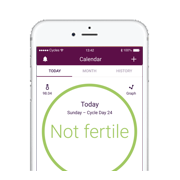Breastfeeding: good for baby—and for mom’s birth control
Effective birth control isn’t always a product made by a pharmaceutical company…

Effective birth control isn’t always a product made by a pharmaceutical company… sometimes our own bodies take care of it for us. Breastfeeding, if done a certain way, can be one of those times. In the first six months after birth, breastfeeding provides many benefits to a new mom and baby—and effective contraception can be one of them.
Breastfeeding-as-birth control is sometimes called the lactational amenorrhea method. Lactational amenorrhea means you’re not getting your period because you’re breastfeeding.
How does it work?
Some of you are probably thinking that the sleep deprivation that accompanies a new baby is an effective form of birth control, given that feeling like a zombie may be inhibiting your sex life. It’s true that not having sex is a great way to not get pregnant, but if you do have sex while breastfeeding (only if you’re breastfeeding in a specific way—see below), biology is on your side to help prevent pregnancy. That’s because, as your baby nurses, a hormone called prolactin increases in your body. This hormone ensures an ongoing milk supply for your baby, and it conveniently also suppresses the hormones that lead to ovulation in you. It’s a natural solution that allows a new mom to devote all her resources to just this one baby for a while.
Wanna try it?
If you plan to rely on breastfeeding as your only form of birth control after birth, it’s super important that you read the fine print.
Ready? Here goes: lactational amenorrhea is 98% effective at preventing pregnancy IF…
It has been less than six months since your baby was born;
Your baby is literally ONLY feeding directly from your breast (that means no formula, no solid food, and no pumped or expressed breast milk fed to your baby from a bottle. Scientists think this is because it’s the actual sucking that triggers the prolactin that stops the ovulation); AND
Your period has not started again.
If you aren’t exclusively breastfeeding your baby (at the breast), you can ovulate as soon as three weeks after giving birth. Yikes! Three weeks is before a lot of women even see a doctor for their postpartum check-up.
Not sure it’s for you?
If you don’t think you’ll meet all three of these conditions for lactational amenorrhea, or if 98% protection just isn’t good enough, talk with your doctor about another form of birth control. Many methods are safe and effective for nursing moms. Condoms, the IUD, the implant, the shot, and progestin-only or mini pills can all be used while nursing. An IUD can even be inserted right after giving birth. Those six months of protection can slip by quickly, so it’s a good idea to start making a plan about another method of birth control.
How do you feel about this article?

Heat up your weekends with our best sex tips and so much more.
